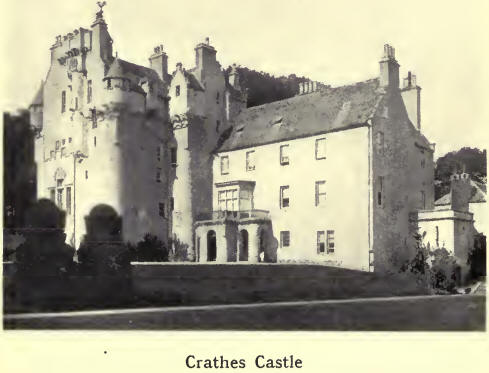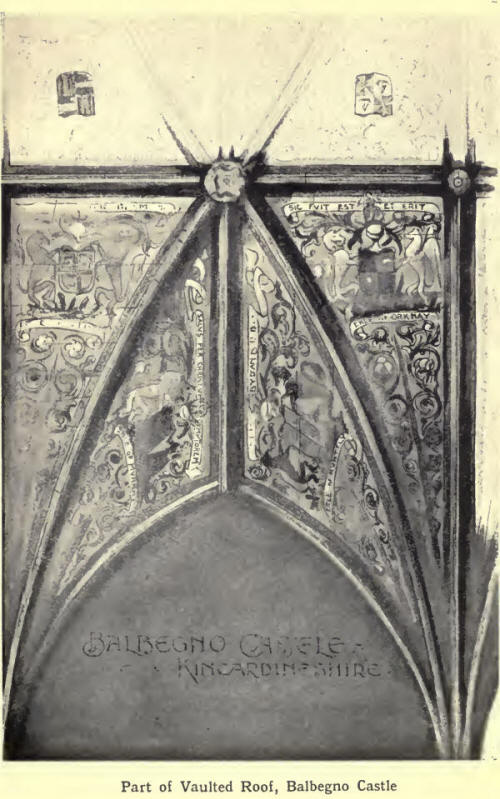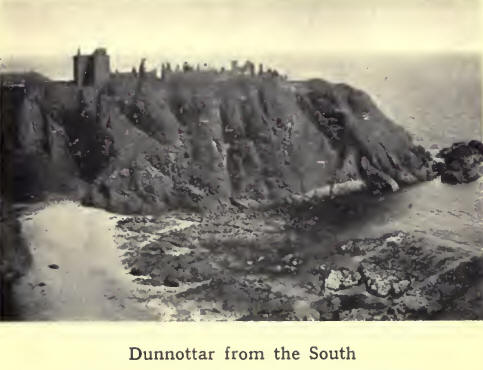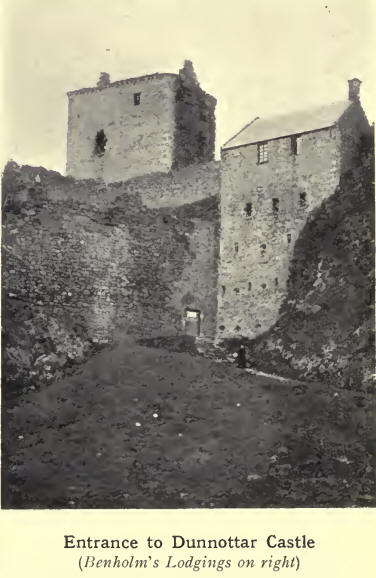The architecture of a
country is a genuine record of its development and progress in
civilisation. In the rude Scotland of early times comfort and
convenience were sacrificed for strength and protection from enemies :
hence the walls of enormous thickness, the strong gates, the moat, and
the ramparts of earth and stone characterising the earliest buildings
that survive. Previous to the Norman Conquest, the building of castles
with stone and lime was not practised, the earliest fortifications being
constructed with earth mounds and wooden palisades on a turf wall. The
position of many of the old castles shows that up to the thirteenth
century, if not later, the builders of the castles trusted more to water
than to hill for their defence. -The steep cliff, facing and perhaps
projecting into the sea, almost surrounded by the breaking waves, and
connected only by a narrow pathway to the mainland, was a typical and
well-chosen spot on which to erect a safe resort in time of danger. The
Kaim of Mathers near St Cyrus, now a roofless relic of the stronghold of
the Barclays, consisted of a tower 40 ft. square and four stories high,
perched on the top of a precipitous rock jutting out into the sea. It
was built, after the murder of Melville the Sheriff (1420), by the laird
of Mathers, who preferred to stay at home, and
“Buyld a lordlie Kaim,
All on the stonie rock,
Which mote defie the sovereign’s arms
Or eke the tempest’s shock.”
The general appearance of the thirteenth-century castles was that of a
huge fortified enclosure. The plan is usually quadrilateral, but more or
less irregular to suit the site. * Cosmo Innes says that Kincardine
Castle, near Fettercairn, was built in the thirteenth century, though it
doubtless occupied the site of several previous royal palaces of wood
and wattle, where Pictish and Scottish kings held state. The castle was
fully 130 ft. square, and had walls of enormous thickness, which were
surrounded by marshes across which no enemy could safely venture.
During the fourteenth century, after the Wars of Independence, there was
very little castle-building in Scotland. Even had the resources of the
country been greater than they were, the nobles were not encouraged by
King Robert Bruce to build strong mansions, as those were liable to be
captured by the English, and the King’s policy was rather to starve the
enemy out of the country than to fight him. The model of the castle
still remained the square tower or Norman keep with very thick walls,
defended from a parapeted path round the top of the tower. Gradually the
simple keep was extended by adding on a small wing at one corner, making
the ground plan of the whole building take the form of the letter L. The
entrance was then placed as a rule at the re-entering angle. The ground
floor was vaulted and used for a store-room. Access from one story to
another was by a narrow corkscrew stair at one corner in the thick wall.
With the outside entrance raised above the ground level and reached only
by a removable ladder, such towers could resist siege and fire, and even
when taken, could not be easily damaged.

The tower of Benholm, now
a part of Benholm Castle, is a fine example of the fifteenth-century
keep. It is crowned with a parapet and angle bartisans, and has on its
top a square cape house or watch turret. This is a primitive indication
of the various additions which were sometimes made on the parapets by
raising them and covering them in with roofs, a feature that may be seen
in several of the later mansions of the Mearns. Fiddes Castle, formerly
a dower-house of the Arbuthnott family, is a very fine example of the
sixteenth-century castle. The general arrangement is that of the L plan,
but the staircase is projected in a large circular tower beyond the
corner of the main building. Another circular tower occupies the
corresponding angle on the opposite side of the main building, and a
third is corbelled out from the first floor on the north side.

In the latter half of the
sixteenth century various influences contributed to a decided change in
castellated architecture. With the introduction of artillery the whole
idea of defeftce became altered. Safety from sudden attack was of more
consequence than the idea of making the castles impregnable : shelter
from the elements was of as great importance as shelter from the enemy.
More attention was paid to ornamental detail, and internal comfort and
convenience. The grim fortress was gradually transformed into the county
mansion, although the keep or quadrangular plan was still adhered to.
The change was of course gradual. The castles were built round a
courtyard, but turrets were placed at every angle of the building. The
lower walls were severely plain. The roofs became high-pitched with
picturesque chimneys, dormer windows, and crow-stepped gables. The
nobles, enriched by the revenues of the church lands secularised after
the Reformation, were enabled either to build, new castles or extend the
old. The effect of the Union in 1603, after which many of the nobility
followed the court to London, was also seen in the higher standard of
domestic comfort and house accommodation vilich imitated that south of
the Border. These features are manifest in Crathes Castle, which
externally presents a wonderful cluster of pinnacles and turrets at the
roof above a plain building with rounded comers below'. The corbelling
and carving are of a very elaborate and ornate character.

Gargoyles at impossible
places, applied as mere ornaments, also occur in profusion. In the east
wall over the doorway, which still presents its original iron “ yett,”
are two shields containing the Burnett arms with the dates of the
erection and completion of the castle, J553 and i596. Balbegno Castle is
another interesting example of a castle on the L plan, into which
various modifications have been introduced. As at Crathes, the whole of
the re-entering angle is filled up, instead of a turret being inserted
in the angle. This is to give provision for a wide staircase to the
first floor. It is one of the few castles in Scotland which have a
ribbed and groined vault over the hall. The compartments of the vaulting
are painted with the armorial bearings of some of the principal families
in Scotland.
Muchalls Castle is a well-preserved specimen of the Scottish mansion of
the beginning of the seventeenth century. It is designed on a plan of
buildings surrounding a courtyard, the north, the east, and part of the
west side of the square being occupied with the house, and the remaining
side enclosed with a wall. The details of the internal decorations are
in the Renaissance style, which began to assert itself in Scotland early
in the seventeenth century. The ceiling of the dining-room is the great
feature of the house. It is ornamented with ribbed plaster work, the
panels being filled in with the heads of Roman emperors, classical
heroes, and Scripture characters.

Apart from its romantic
and historical associations, Dunnottar Castle is of great architectural
interest, for it exhibits the various changes which took place in the
disposition of buildings and defences, as well as in the domestic
arrangements, from the fifteenth to the seventeenth century. Dunnottar
signifies a strong promontory, and the situation justifies the name. The
castle stands on the platform of an isolated rock washed on three sides
by the sea. The perpendicular cliffs rise to a height of 160 ft. except
at the narrow strip of land on the level’of the seashore, by which it is
joined to the mainland. The area of the site is about 3! acres. A very
short steep path leads to the gateway, on the right of which is “
Benholm’s Lodgings,” a five-storied building, furnished with three tiers
of loopholes. A strong portcullis had closed down the gateway, within
which, to left and right respectively, are the guard-room and the
prison, the whole of the open approach being effectively commanded from
the buildings above and from the parapets. The oldest building is
undoubtedly the keep or tower at the south-west corner of the platform,
which dates from the early part of the fifteenth century. The plan
presents the usual arrangement of the period, the L shape, four stories
in height, and with walls 5 ft. thick. Further to the cast is an
extensive range containing stables and the Priest’s House. This part
belongs to the latter half of the sixteenth century. The church is next
in order. The original church, consecrated in 1246, stood on this site.
To it the lower part of the south wall belongs, but the rest of the
building was reconstructed early in the sixteenth century. Part of the
church must, therefore, be the oldest-built work in the castle. The
walls, were at one time ornamented with monuments to'the Keiths, but
they have all disappeared. The latest addition to the castle is the
projecting wing at the north-east corner of the quadrangle. Its ground
floor contains a vaulted apartment 58 ft. long and 15 ft. wide.
Originally intended as a store-room, it gained an unenviable notoriety
as the prison of the Covenanters, or Whigs’ Vault. There are curious
niches in the walls, apparently intended for the insertion of prisoners’
hands when torture was applied for misdemeanours. Below the Whigs’ Vault
is a smaller one, where, it is said, no fewer than forty-two of the
Covenanters were confined for a time. From the Whigs’ Vault, by the
great staircase, we reach the dining-room, the windows of which give a
wide prospect of sea and wild cliffs.
|

